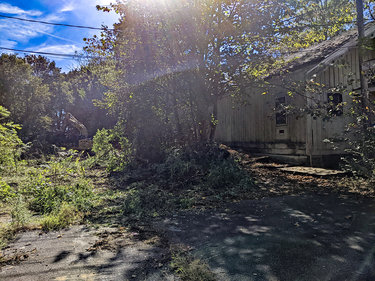Depot in disrepair is demolished
ALTAMONT — The 161-year-old village train depot is no more. Work started with trees being cut on Thursday morning, Oct. 2, and by evening the station was a pile of rubble.
The neglected structure was located behind the restored 1897 train station that now serves as Altamont’s library and is on property owned by Jeff Thomas.
Thomas was at the scene on Thursday as Ditonno & Sons Demolition began work.
He said the village had condemned the building so it had to come down.
“A lot of people worried about kids going in there and getting hurt,” he said.
The Altamont Building Department did not immediately return a call from The Enterprise.
Thomas said the demolition, which cost him “roughly $65,000,” would take several days to a week to complete.
He described the trees being removed as “scrub trees,” adding, “There are no big trees of any value. It used to be open.”
Thomas had told The Enterprise in December 2022, when the roof of the depot collapsed under heavy snow, “Our plan is to restore that, keep a section of it … We’d have it engineered and work from the inside out.”
A depot in Slingerlands built in the same year, 1864, and in a similar style has been restored. It is located near the Helderberg-Hudson Rail Trail. A $425,000 state grant was recently announced that will be used to upgrade the depot into a community gathering place where information on healthy living and on the county’s rail trail will be available.
Thomas told The Enterprise on Thursday that the Altamont depot had fallen into such disrepair that there was “nothing structural that could be saved.” He went on, “It was not built good, and it was abused over many years.”
A brick building next to the wooden depot is not being demolished; it will continue to be leased by T.E.C. Northeast Fire Systems, Thomas said, until he develops the parcel further.
When he gets approval for his current development plan, Thomas said, the brick building will be demolished along with Altamont’s mid-century post office, which Thomas also owns.
Thomas plans to build a new post office, mixed-use space, and stand-alone residences on his 1.86-acre parcel, which is bounded by Orsini Park and the Altamont Free Library to the north, Norfolk Southern’s rail line to the west, the Altamont fairgrounds to the south, and Park Street to the east.
He abandoned earlier plans for that parcel when they did not meet with approval by the village planning board.
The post office, Thomas said on Thursday, wants 6,000 square feet while its current Eisenhower-era building is half that.
Thomas, who lives in Knox on the Helderberg escarpment overlooking Altamont, has been active in village real-estate development, owning and upgrading what he named the Altamont Corners shopping plaza, which is on the other side of the railroad tracks from the old train station, and the Park House Apartments, and building the Brandle Meadows senior housing on the outskirts of the village.
He also owns the gateway-to-the-village property on Route 146, which is rented to the Broadview Federal Credit Union. He said he has had no credible offers for the property he owns across from the credit union, site of the old Penguin Diner.
Thomas also owns the 2,800-square-foot building on Park Street that used to house KeyBank and the library, on the edge of which the Altamont Community Kiosk was just built. “Dollar General wanted the bank building, but it wouldn’t fit with the community, so I wouldn’t do it,” said Thomas, adding that he has a current prospect for that property but it is confidential.
Thomas sees his proposal for the village center as “Victorian-look that would improve curb appeal.”
He went on, “To develop this last little piece of land, I think will enhance the character of the village …. I think it’s magnificent.”
Depot history
“When the trains began arriving at Knowersville in the autumn of 1863, there wasn’t much to be seen,” wrote Guilderland Town Historian Mary Ellen Johnson in a 2022 Enterprise column about trains coming to what is now called Altamont.
The sleepy rural hamlet boomed with the coming of the railroad.
The Severson family’s Wayside Inn (now the site of Stewart’s in Altamont) had been put out of business when the Schoharie Plank Road opened in 1849, relocating traffic a half-mile away following a route less taxing to horses than straight up the escarpment as it had been near Severson Tavern.
Once the railroad began operations, the Plank Road Company quickly went out of business.
While some along the way had objected to the railroad coming through their property, the Seversons were happy to give a right-of-way across their farm.
Within four years of the railroad’s opening, George Severson had built Severson House, a hotel across the tracks from the small 1864 depot that the Albany & Susquehanna had erected for the Knowersville stop.
The Severson farm and others nearby were divided into valuable building lots. A building boom began in the vicinity of the tracks with many homes and businesses going up in the next few years.
The original Knowerville, east of present day Gun Club Road, became a quiet neighborhood known as the “old village” in later years. The Knowersville post office was soon moved to the new center of population in the depot.
“This building served as a combination freight and passenger station,” according to a history written by the late Roger Keenholts, former village historian, and posted to the library’s website. “As the village grew, the depot soon became an unofficial village hall and meeting place.
“The early station agents were also enterprising businessmen and conducted extensive business from the depot, selling building materials, feed and coal. The first agent, Henry Hawkins, served as the postmaster for Knowersville and the post office was located in the depot.
“In 1896, the railroad at last agreed to replace the 1864 structure. A contract was awarded to Hiram Schoonmaker, a local builder, to remove the original station some 400 feet south along the tracks and to build a new depot ….
“In the 1950’s, the building was leased out to the Albany County Highway Department as offices and storage. In December 1984, the property was sold to the Altamont Tile Company who erected an addition on the north end of the building and opened an office and showroom. The building was later purchased [by] the TEC Northeast Fire Systems.”



